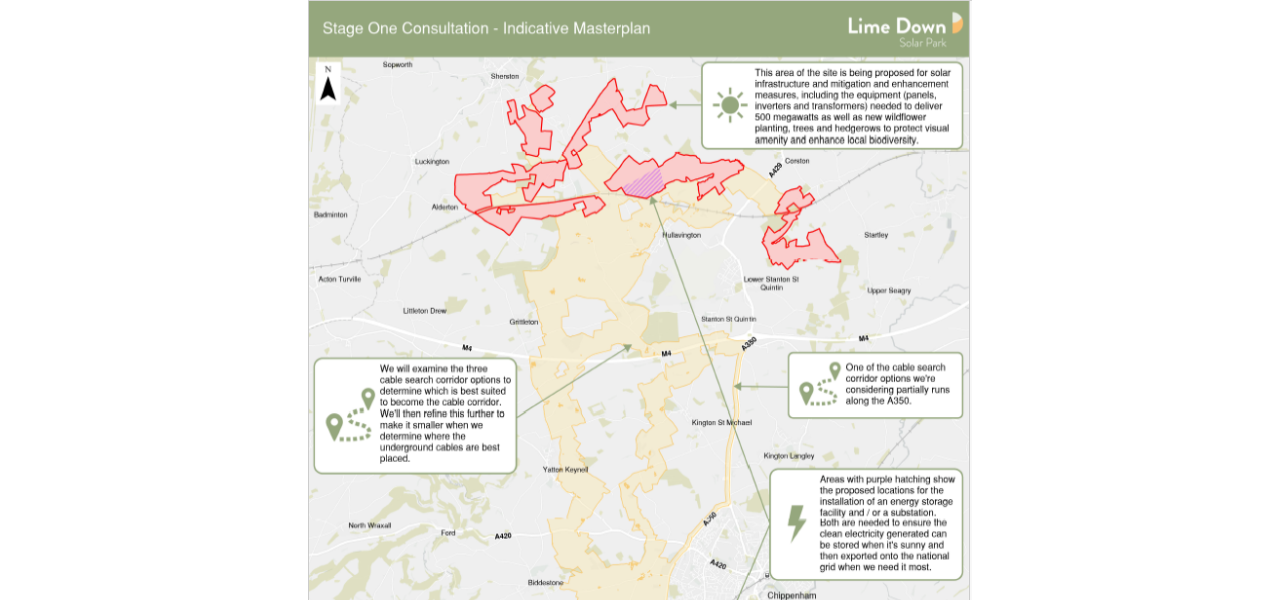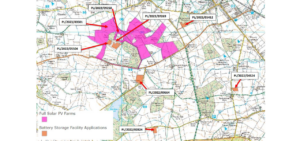Lime Down Solar Park

The map above shows the areas of fields to the south west of Malmesbury that would be covered in solar panels if the Lime Down Solar Park is approved.
This enormous solar farm, some 2000 acres in size, would lie a few miles to the west of another area of multiple solar farms and BESS units in Wiltshire, at Minety, which is shown on this map:

CPRE Wiltshire’s position on solar farms, which exactly accords with that of the CPRE national policy, is that we welcome renewable energy generation but not at the expensive of our countryside, especially where agricultural land is threatened. Wiltshire has already provided far more than it’s target share of solar power generation. There are huge areas of rooftops, both on industrial sites and on housing, that could be used to provide solar power generation. Other brownfield sites, especially those not so suitable for building affordable houses, could also be used, either for solar panels or for Battery Energy Storage Systems (BESS), or both. For more on this, see CPRE’s latest article on rooftop solar here and their article on how the potential of rooftop solar is being overlooked here.
The relevant Planning Practice Guidance advises that:
“The approach to assessing cumulative landscape and visual impact of large scale solar farms is likely to be the same as assessing the impact of wind turbines. However, in the case of ground-mounted solar panels it should be noted that with effective screening and appropriate land topography the area of a zone of visual influence could be zero”
This is loophole wording which encourages applications. Who should decide what is “effective screening”?
Cumulative landscape impacts are the effects of a proposed development on the fabric, character and quality of the landscape; it is concerned with the degree to which a proposed renewable energy development will become a significant or defining characteristic of the landscape. In identifying impacts on landscape, considerations include: direct and indirect effects, cumulative impacts and temporary and permanent impacts. When assessing the significance of impacts a number of criteria should be considered including the sensitivity of the landscape and visual resource and the magnitude or size of the predicted change
Cumulative visual impacts concern the degree to which proposed renewable energy development will become a feature in particular views (or sequences of views), and the impact this has upon the people experiencing those views. Cumulative visual impacts may arise where two or more of the same type of renewable energy development will be visible from the same point, or will be visible shortly after each other along the same journey. Hence, it should not be assumed that, just because no other sites will be visible from the proposed development site, the proposal will not create any cumulative impacts In assessing the impact on visual amenity, factors to consider include: establishing the area in which a proposed development may be visible, identifying key viewpoints, the people who experience the views and the nature of the views.
The Wiltshire Council Landscape Officer’s opinion in describing this on one recent application : “the series of individual planning applications seeking planning permission for BESSs is harmfully changing the existing rural character of pastoral farmland into an industrialising urban sprawl radiating outwards” and
“the overhead electricity transmission lines and their supporting pylons are visible elements in the countryside leading towards and away from the substation, but the local landscape retains its inherent peaceful pastoral character with the sparse rural settlement, presence of woodland and common land all contributing to this area’s inherent rural, tranquil character. The presence of a water tower or the pylons crossing this landscape does not significantly alter the inherent peaceful character of the countryside, but the character of countryside around the substation continues to decline from piecemeal industrialising development radiating outwards”.
A campaign group “Stop Lime Down Solar Park” has been formed. You can read more about this and sign their petition here.



